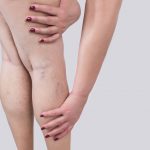Learn Whether You May Be More Likely to Develop Varicose Veins

Like so many health concerns, there are several risk factors for varicose veins. Some of the reasons you may be more likely to develop varicose veins are outside of your control, but there are also some things you can do to help prevent varicose veins, or improve existing veins.
What Causes Varicose Veins?
Varicose veins are veins you can see through your skin that can range in appearance from tiny and web-like (known as spider veins) to larger, twisted veins that may create a bulge and cause a heavy feeling, aching, or pain in the area.
Varicose veins are caused by weakened valves in the vascular system which pump blood through the body. Your veins contain tiny valves to help keep blood flowing in the right direction. When the valves become weak, gravity can cause blood to collect, leading to the appearance of varicose veins.
While they may cause some discomfort, varicose veins are usually not dangerous. However, if the area becomes red, warm, hard, or very painful, you should seek medical attention because this could be a sign of a clot or inflammation in the vein.
What are the Risk Factors for Varicose Veins?
Unavoidable Risk Factors for Varicose Veins
Family History
Varicose veins are genetic, meaning they run in families. While this is not the only factor that affects the appearance of varicose veins, it is a strong predictor.
Age
Not every person will develop varicose veins as they age, but the risk does increase with your age.
Sex
Varicose and spider veins are more common in women than in men. This is likely tied to female hormones, which can weaken veins. Hormone treatments such as birth control pills can also increase the risk of developing varicose veins.
Pregnancy
Varicose veins are common in pregnancy. Along with hormonal changes, blood volume increases significantly during pregnancy to support the developing baby. This can cause veins to become enlarged. Varicose veins often fade over several months after the pregnancy. Having multiple pregnancies, however, is also a risk factor for developing varicose veins.
Avoidable Risk Factors for Varicose Veins
Obesity
Being overweight increases the likelihood of varicose veins. Excess weight impacts your vascular system and puts pressure on your veins.
Sedentary Lifestyle
Sitting for long periods of time and not being active can impact vascular health. A sedentary lifestyle can negatively impact health in many ways, including increasing your risk for varicose veins or increasing their severity if you have them.
Standing for Long Periods of Time
Similar to sitting for long periods, standing for long periods also can increase the likelihood of varicose veins. While this appears counterintuitive at first, it is the lack of movement that can impact the vascular system negatively. Whether you sit or stand for long periods, trying to move around more can help.
Smoking or Vaping
Smoking (or vaping) can have extremely serious health effects, including weakening your cardiovascular system as a whole. It can also cause weakening in vein structure, contributing to varicose veins.
Healthy Day-to-Day Tips to Prevent Bulging Veins and Improve Vein Health
Can you prevent varicose veins? While you may not be able to avoid all risk factors, there are many ways you can improve your lifestyle to prevent varicose veins or improve the appearance of your skin.
Regular Exercise
Regular exercise increases your overall cardiovascular health. Fortunately, almost any form of exercise can have an effect, although more challenging exercise will have more significant results. Focus on the types of exercise you enjoy and are capable of sticking with.
Movement
In addition to exercise, simply adding small spurts of movement throughout your day can have a significant effect. If you sit or stand still for long periods of time, for example, try to add regular movement, even if it is just pacing the room for a short time.
Elevation or Compression
There are some ways to give your veins a little help or rest when it comes to moving your blood through them. One option is to elevate your legs for around 15 minutes per day. This allows gravity to work with your blood flow rather than against it and gives the veins in your legs a much-needed break. Another option is wearing compression socks, which can give your legs added support.
Watch Your Weight
Maintaining a healthy weight, or losing weight if you are overweight, can significantly improve not only varicose veins but your overall health.
Eat Healthy and Stay Hydrated
Eating a balanced diet with lots of fruits and vegetables can improve overall health, including vein structure and circulation. Getting proper hydration improves the viscosity of your blood and maintains healthy vein and arterial walls.
Get Treatment
There are many treatment options for varicose veins, including sclerotherapy injections and laser therapies. These procedures can help with the appearance and discomfort associated with varicose veins. Reach out today to learn which might be right for you.



